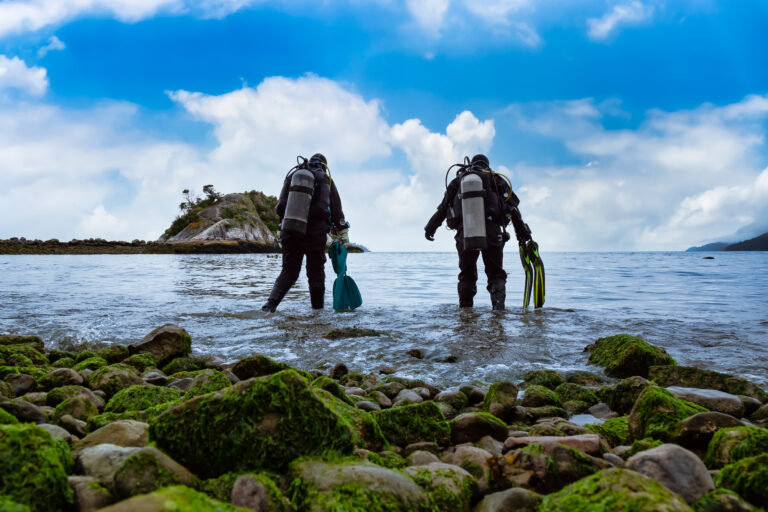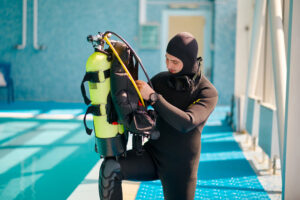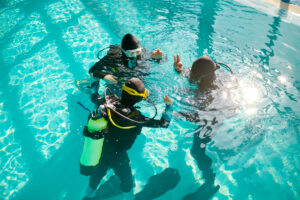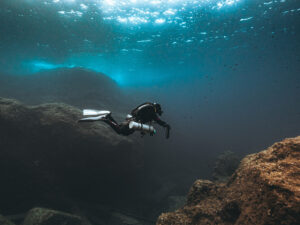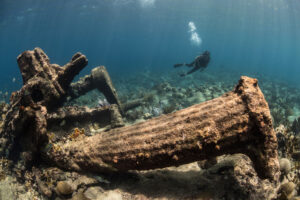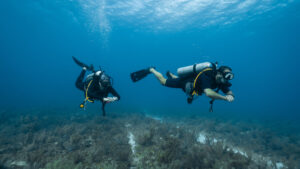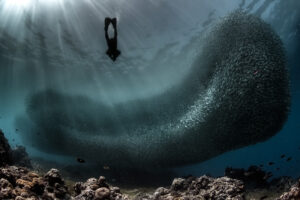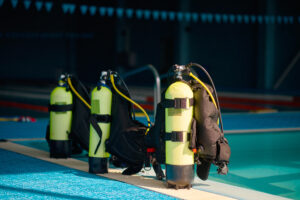What is Shore Diving?
Shore diving, often referred to as beach diving, is a type of scuba diving where divers enter the water directly from a beach, rocky shore, or shoreline rather than from a boat. This method of diving is popular for its accessibility and the freedom it offers divers to explore underwater environments at their own pace. Unlike boat diving, which requires specialized equipment, crew, and often significant planning, shore diving allows divers to engage with underwater ecosystems with fewer logistical hurdles. By walking directly into the water, divers can quickly immerse themselves in the marine world, making it an attractive option for both beginners and experienced divers.
Advantages of Shore Diving
Accessibility
One of the primary advantages of shore diving is its ease of access. Unlike boat diving, which often involves transportation to distant dive sites, shore diving allows divers to enter the water directly from nearby shores. This accessibility makes diving more affordable and straightforward, especially for those who live near coastal areas or have limited access to boats. The elimination of boat-related expenses, such as fees for fuel, crew, and equipment, makes shore diving a cost-effective option for many. Furthermore, there is no need to coordinate with a boat operator, which can be a logistical challenge, especially in peak diving seasons. Divers can simply choose a location, plan their dive, and begin their underwater journey without waiting for a scheduled departure.
The flexibility provided by shore diving makes it particularly appealing to those who wish to dive more frequently. As there are fewer restrictions related to timing, individuals can enjoy more spontaneous dive trips. This is especially beneficial for divers who live near the coast and want to incorporate diving into their routine without the constraints of planning ahead for boat trips.
Flexibility
Shore diving offers divers the ability to explore underwater environments at their own pace. Without the need to adhere to a boat’s timetable or follow a group’s schedule, divers have the freedom to manage their own dive plan. They can choose how long to stay underwater, when to start or finish the dive, and where to explore. This autonomy allows for more tailored diving experiences, where individuals can focus on specific interests, such as marine life photography or studying underwater ecosystems.
The flexibility also extends to dive site selection. While boat dives often target specific, pre-determined sites, shore diving offers more choice in terms of entry and exit points. Depending on the conditions, divers can adjust their plans and explore different sections of a shoreline, investigating areas that may be inaccessible by boat. This flexibility is ideal for divers who want a more personalized or intimate diving experience, as they are not confined by the constraints of a group or a specific dive site.
Shallow Water Diving
Many shore dives occur in shallow waters, making them well-suited for beginners or those who prefer less depth-intensive dives. The gradual slope of many shorelines allows divers to ease into deeper waters at their own comfort level. Shallow dive sites are also a great environment for marine photography, as the abundance of natural light enhances visibility and the vividness of underwater subjects. Snorkelers, too, benefit from shore diving, as they can often explore the same areas without needing to venture too far from the shore.
In addition to being beginner-friendly, shallow water diving offers more opportunities for observing marine life. Many marine species inhabit coastal environments, making them easily accessible to shore divers. The shallow depth also allows for longer dive times, as air consumption is generally slower at shallower depths. This combination of factors makes shallow shore diving a popular choice for those interested in marine biology, underwater photography, or simply enjoying a relaxed, low-stress diving experience.
Environmentally Friendly
Shore diving has a lower environmental impact compared to boat diving, which requires the use of fuel and emits pollutants into the atmosphere and water. The absence of a boat minimizes the risk of accidental damage to marine ecosystems, such as coral reefs, which can be harmed by boat anchors or propellers. By eliminating the need for fuel-powered boats, shore diving helps reduce noise pollution, which can disrupt marine life, especially sensitive species like whales and dolphins that rely on echolocation for communication.
Additionally, shore diving provides an opportunity to practice eco-friendly diving habits. Divers can easily access areas where they can collect marine debris or monitor the health of coastal ecosystems. Since divers can enter and exit the water without the use of heavy machinery or infrastructure, the overall impact on marine environments is minimized. Many shore diving locations are designated as protected marine areas, and the reduced traffic from boats helps preserve the delicate ecosystems that thrive in these coastal regions.
Challenges of Shore Diving
Entry and Exit
One of the main challenges of shore diving is entering and exiting the water. While boat diving involves simply jumping or stepping into the water from a platform, shore diving requires navigating a variety of shorelines, which may include rocks, sand, or coral. These terrains can make entry difficult, especially in areas with surf or strong waves. Divers must be prepared to deal with the physical effort involved in carrying gear over uneven ground, often while contending with slippery surfaces and unstable footing.
In addition to the physical challenges, surf and waves present another obstacle. For divers entering the water from a beach with strong surf, timing is crucial to avoid being knocked over or pushed back to shore. Surf entry techniques, such as the use of fins and the proper timing of wave sets, are essential for ensuring a safe and smooth entry. The same considerations apply during exit, where divers must often remove their fins in shallow water and walk back to shore while managing the weight of their gear. For less experienced divers or those unfamiliar with specific dive sites, these entry and exit challenges can present significant obstacles.
Limited Sites
Shore diving is constrained by geography, meaning that suitable dive sites are not always readily available. Divers are limited to areas with safe and accessible entry points, and not all coastal regions offer these conditions. Some shorelines may be private property or protected by environmental regulations that restrict access. Furthermore, certain coastal areas may have challenging underwater conditions, such as strong currents or limited visibility, making them unsuitable for shore diving.
In regions where dive sites are accessible, divers may face crowded conditions, especially in popular locations. The limited availability of ideal shore dive spots can lead to overcrowding, which may diminish the quality of the diving experience. Additionally, repeated use of the same shorelines can lead to environmental degradation, such as damage to coral reefs and erosion of the coastline. As a result, shore divers must take care to select sites that are both safe and ecologically sustainable.
Surface Swims
Another challenge associated with shore diving is the need for surface swims. Unlike boat dives, where divers are dropped directly over the dive site, shore dives often require divers to swim on the surface for a considerable distance before descending. This can be physically demanding, especially when carrying full scuba gear. Surface swims can be tiring and may require divers to conserve energy before starting the actual dive. In some cases, divers may need to swim against currents or waves, adding to the difficulty.
The time spent swimming on the surface also limits the overall dive time. Divers must be mindful of their air consumption, as they may need to return to shore with enough air left to complete the surface swim back to the entry point. Proper planning and pacing are essential for managing surface swims, especially for divers unfamiliar with the area or its conditions.
Weather Conditions
Shore diving is more vulnerable to changing weather conditions compared to boat diving. Factors such as tides, currents, and wave action can drastically impact the safety and enjoyment of a shore dive. A sudden change in weather can result in rough surf, poor visibility, and stronger currents, making entry and exit more dangerous. Tidal fluctuations can also influence the depth of the water at the entry point, potentially limiting access to certain dive sites during low tide.
Weather conditions also affect underwater visibility. Increased wave action can stir up sediment, reducing visibility and making navigation more difficult. Divers must remain vigilant about changing conditions and be prepared to adjust their dive plan accordingly. In some cases, shore dives may need to be postponed or canceled due to unfavorable weather, limiting the opportunities for diving in certain regions or seasons.
Techniques for Shore Diving
Pre-dive Planning
Thorough planning is a key component of a successful shore dive. Divers should research potential dive sites, familiarize themselves with the conditions, and identify entry and exit points. Factors such as tide schedules, weather forecasts, and marine life activity should be taken into account to ensure a safe and enjoyable dive. Maps and guides, as well as local knowledge from other divers or dive shops, can provide valuable information about underwater hazards, currents, and points of interest.
Planning also involves preparing for potential challenges, such as changing conditions or equipment malfunctions. A backup plan is essential in case the primary dive site becomes inaccessible or conditions worsen. Divers should also inform someone on land about their dive plan, including the location and estimated duration of the dive, to ensure safety in case of an emergency.
Buddy System
Shore diving should never be done alone. The buddy system is a crucial safety measure, providing divers with mutual support in case of an emergency. Diving with a buddy enhances overall safety, especially in challenging conditions such as rough surf or low visibility. Buddies can assist each other with equipment, share air in the event of a shortage, and help navigate back to shore.
In addition to safety, diving with a buddy improves the overall diving experience. Buddies can work together to spot marine life, assist with underwater navigation, and document the dive through photography or video. Communication and coordination between dive buddies are essential for a smooth and enjoyable shore dive.
Gear Management
Proper gear management is critical when shore diving. Unlike boat diving, where gear can be easily stowed or handled by crew members, shore divers must take full responsibility for managing their equipment. Divers should organize and prepare their gear before entering the water, ensuring that everything is functioning properly. It’s important to secure non-diving belongings, such as clothes or bags, above the waterline to prevent them from being swept away by tides or waves.
Carrying gear across the beach or rocky shore can be physically demanding, especially when dealing with the weight of scuba tanks, regulators, and other equipment. Divers should consider the distance to the entry point and plan accordingly, conserving energy for the actual dive. Once in the water, proper buoyancy control is essential to avoid damaging the marine environment or stirring up sediment.
Entry Techniques
The entry technique used in shore diving depends on the conditions of the shore. For calm waters and sandy beaches, a giant stride entry may be appropriate, allowing divers to step directly into the water. In areas with waves or rocky terrain, a controlled seated entry may be more effective, allowing divers to enter the water slowly and with greater stability. Surf entry techniques, where divers use their fins to navigate through the surf, are essential for handling rough conditions.
Divers must assess the environment before choosing their entry technique. Factors such as wave height, water depth, and the presence of rocks or coral can affect the safety and difficulty of the entry. It’s important to remain calm and focused during the entry, especially in challenging conditions.
Navigation
Underwater navigation is a critical skill for shore divers, as they must return to the same entry point for a safe exit. Without the visual landmarks provided by a boat, divers need to rely on natural features such as rock formations, coral, and the slope of the sea floor to guide their way back to shore. A compass can be a valuable tool for navigation, especially in areas with low visibility or strong currents.
Distance estimation is another important aspect of navigation. Divers should keep track of their depth and the time spent underwater to ensure they have enough air for the return trip. By practicing navigation skills and maintaining situational awareness, divers can avoid becoming disoriented and ensure a safe and successful shore dive.
Safety Precautions
Safety is paramount in shore diving. Divers must continuously monitor their air supply, depth, and no-decompression limits throughout the dive. Carrying a surface marker buoy (SMB) is essential for signaling to boats or others on the surface, especially in areas with boat traffic. A whistle or other signaling device can also be helpful in attracting attention in an emergency.
Divers should be aware of potential hazards such as entanglements, sharp rocks, or marine life that may pose a threat. Regularly checking conditions, such as the strength of currents or changes in visibility, is essential for making informed decisions about the dive. In the event of an emergency, divers should have a plan in place to surface safely and return to shore as quickly as possible.
Key Takeaways
Shore diving offers a unique opportunity to explore underwater ecosystems without the need for a boat, providing flexibility, accessibility, and environmental benefits. However, it also presents challenges, including difficult entry and exit points, limited dive sites, and the need for careful planning. By mastering essential techniques and taking necessary safety precautions, divers can enjoy the rich underwater world accessible from the shoreline.

